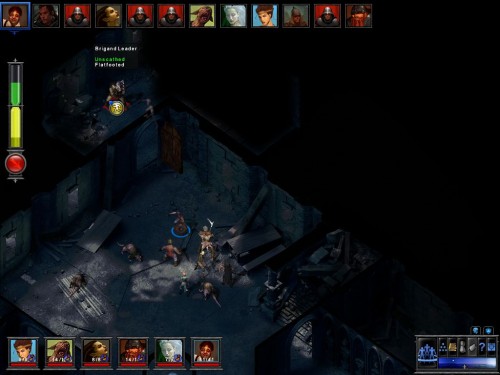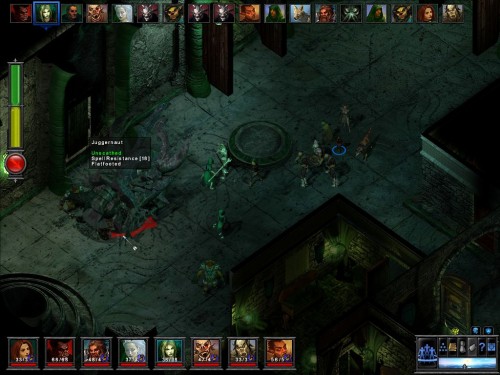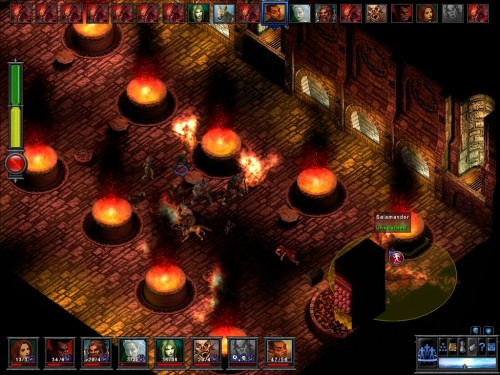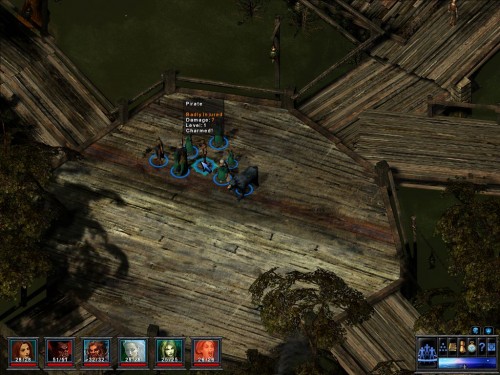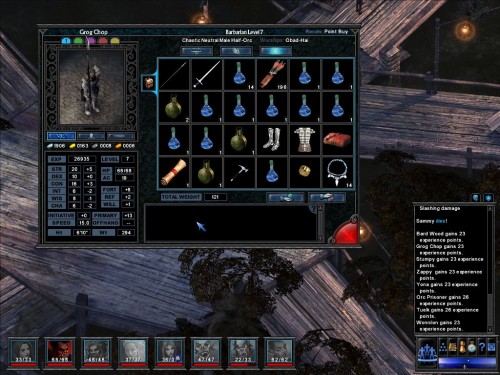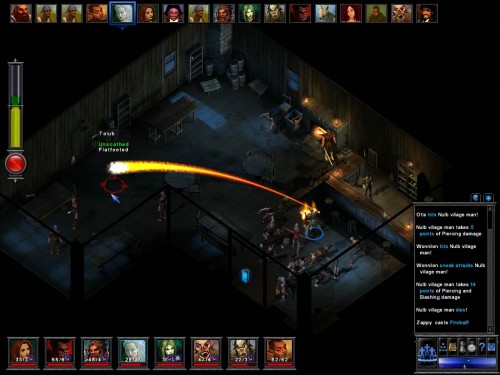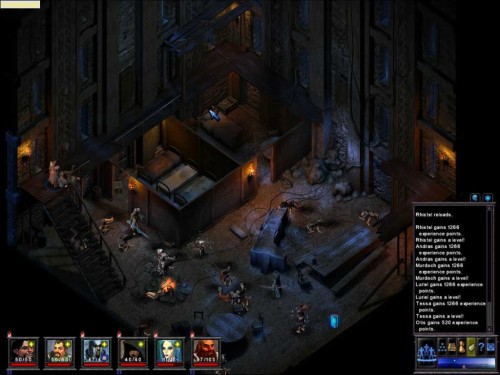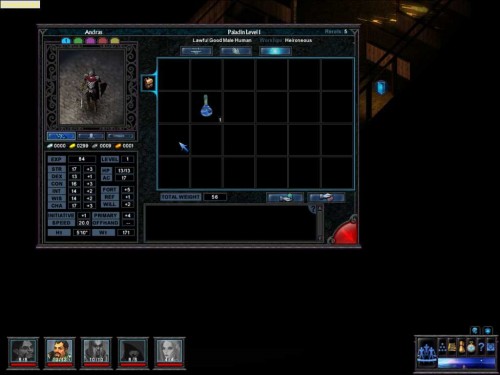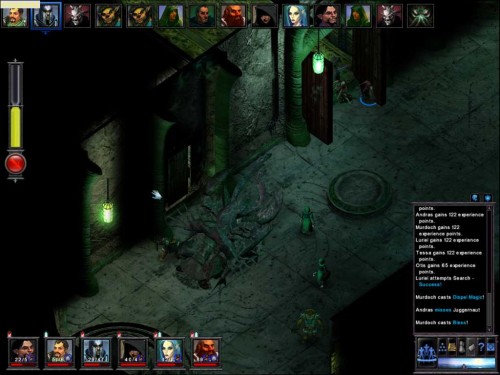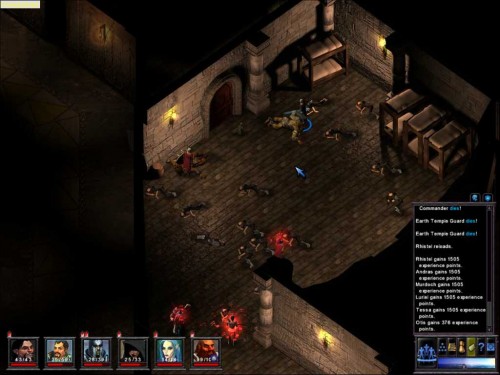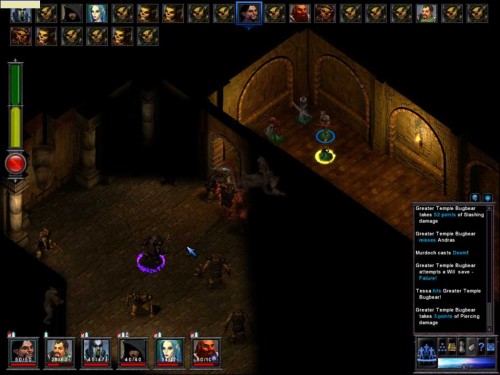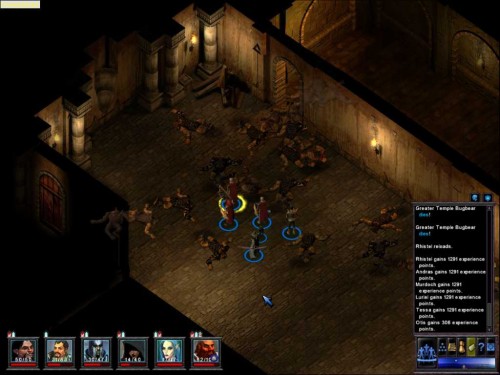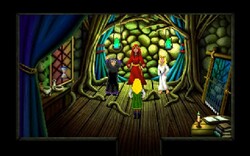Temple of Elemental Evil Review
Temple of Elemental Evil Review
Codex Review - posted by Spazmo on Thu 2 October 2003, 14:02:33
Tags: Temple of Elemental Evil; Troika GamesThe Essence of D&D
It's not easy being Tim Cain. When you're the man behind a legendary game like Fallout, expectations for your next games are high. So when Tim Cain, Jason Anderson and Leon Boyarsky left Interplay in 1998 to start up their own company, the pressure was on. In 2001,Troika and Sierra released Arcanum, which was to be everything Tim Cain ever wanted to make but couldn't while he was with Interplay. However, while Arcanum was excellent from a role-playing point of view, its combat and character system left something to be desired. Nonetheless, the game was well received, with most fans agreeing that Arcanum would have been truly excellent if only the developers hadn't been burdened with including a real-time mode. The general consensus was that if Troika were allowed to make a pure turn-based game, it would shine.
So here we are, about a year and a half later. It's late 2002 and rumors are circulating that a Troika team headed up by none other than Tim Cain is working on a CRPG remake of the classic Temple of Elemental Evil module penned by (arguably) the father of role-playing games himself, E. Gary Gygax. Finally, an announcement comes: Troika is indeed developing Dungeons & Dragons: The Temple of Elemental Evil: A Classic Greyhawk Adventure (which wins the prize for longest title ever) for Atari and it will be the most accurate rendition of the D&D rules yet on PC--including full--out turn-based combat. Interview after interview promises nifty new features and intriguing gameplay mechanics, driving Troika fans and D&D buffs alike into a joyful frenzy--and all without a single screenshot! Gamers were extremely excited about ToEE. Tim Cain would have to make a truly excellent game to live up to the expectations that were being laid on him.
And fortunately, they have succeeded. Despite a number of bothersome bugs, a few dubious design decisions and some last minute gutting by fearful--cowardly, even--Hasbro executives, ToEE is a brilliant game with quite possibly the best combat ever seen in any RPG to date.
In ToEE, you play as a group of one to five adventurers who can be of any race or class allowed within the D&D 3.5 ruleset. The character creation process is, in fact, one of the most fun parts of the game since the possibilities at this stage are numerous. With five characters to create and all the choices presented by the flexible D&D system, you could very easily be at it for hours. ToEE gives you full control over your character's development, allowing you to pick which skills to increase, which feats to learn and even to multiclass yourself into another path to increase your range of abilities. For those who would rather not delve into the mysterious depths of D&D, a variety of pre-made characters is available to be tossed into your party, although you will be on your own when levelling up these pre-made PCs. One important (and new--this rule doesn't appear in the original D&D rules) choice you'll have to make when creating your party is party alignment. Party alignment dictates what kind of characters you can let into your party as well as the opening of the game--more on that later.
The character creation system makes it obvious right off the bat that ToEE is the kind of game that will kick your ass if you don't know what you're doing. You have to be careful in selecting how you develop your characters or you could very easily end up with a group that isn't very good at anything. Fortunately, the game includes a beefy and gloriously spiral-bound manual with all the information you need to get through the game. Reading this manual is critical is properly understanding how the game works and how to succeed in it and is certainly one of the better manuals I've seen in recent times.
And even after you've created your party, you can still add more characters to the mix. ToEE features a great number of hireable NPC followers who will join your party and help out in combat. Most of these simply demand a share of the loot and whenever you loot a monster's corpse or a chest, followers will automatically take their share of the swag no matter where they are at the time, which can often be problematic as the followers aren't terribly picky in what loot they grab. My party picked up a sword-wielding fighter to round out the group's melee combat abilities. While the fighter never did grab stuff that wasn't appropriate to his class--items like wands or scrolls better suited to arcane or divine spellcasters--he did have an unfortunate tendency to grab items that were utterly useless. All too often, my follower would be heavily laden with useless junk like wooden shields and suits of leather armor, leaving him hopelessly encumbered and less useful in combat. Besides that, all followers seem to be able to grab their loot no matter where they are as well as getting first pick of the loot. Another interesting thing is that although followers refuse to let you take items flagged as theirs (though you can still tell them what bit of equipment to wear when), you only have to visit any shopkeeper to remove the "NPC's property" flag from your follower's loot, making the whole idea of things belonging to them somewhat useless. The follower looting scripts could definitely use an overhaul.
Bells and whistles
Once you've finished making your party, you can then begin the game itself. This is where ToEE introduces another interesting feature: opening vignettes. When you select your party alignment, you're also choosing how the game starts. Neutral Good parties stumble upon the murderer of an important priestess, which leads them to Hommlet. Evil parties might be tasked with destroying an artefact of good located in Hommlet. Whatever the reason, all groups eventually find themselves in Hommlet, which is where our adventure begins. Starting vignettes are an interesting idea, but it seems like their potential hasn't been fully exploited in ToEE. The one I played was very short and felt somewhat contrived. If done better, however, I feel starting vignettes could become a staple in RPGs.
Aside from vignettes, ToEE has got a whole bunch of nifty and/or useful features. You can actually see a spell's area of effect before casting it--players whose parties have died from accidentally misplaced fireballs in Infinity Engine games will appreciate this. Pressing alt while in combat will let you see the path the currently selected party member will take to his objective and what kind of trouble they'll get into on the way. Reams and reams of game information can easily be accessed through a convenient hyperlink system - just click on any word highlighted in blue in the information window to get detailed information on it. Most of these features just plain make sense but haven't appeared in many recent RPGs.
It's also nice to see many D&D spells aren't as bastardized in ToEE as they have been in past D&D titles. Teleport is in the game, something that was mysteriously lacking in all the BioWare D&D games. Charm person, another P&P favorite of many D&D veterans, is implemented quite well in ToEE. Rather than reworking several elements of D&D to make it fit better into a computer game, Troika just tossed all this stuff into ToEE as is. And, wouldn't you know it, it works just fine.
The game's interface is also worthy of praise. The game uses a fairly simple radial menu system to let you control your characters. This is good because it means you have less buttons permanently on the screen. Look at any ToEE screenshot and you'll notice how little room the interface takes up, leaving lots and lots of viewing space which helps a lot to keep track of everything that's happening.
Besides that, ToEE has also got beautiful graphics. The 3D models are extremely well done with lovely textures and fluid animations. The animations for critical hits are particularly nice, if only for the satisfaction of a solid crit. The various spell effects are also marvellously done. The magic missile animation is especially nice with missiles tracing elaborate trajectories, bouncing like tennis balls and even spiralling around their targets before striking them. Trees and stalks of wheat sway in the wind. Fireflies and other insects fly about. All these effects contribute to make ToEE a visually rich and detailed game. The sound is equally well done with very good music in MP3 format, allowing players to enjoy ToEE's music outside of the game. For example, it'd make fantastic ambience music for an actual pen-and-paper D&D session. Another nice feature previously unseen in D&D CRPGs is item crafting. Admittedly, Neverwinter Nights let you combine certain items in magic forges to create more powerful ones, but that mechanic was a hollow mockery of the real D&D item crafting rules, which ToEE follows to a T. Essentially, the game lets you brew potions and make a wide variety of items provided you:
Writing a scroll of a first-level spell won't cost you very much at all, but whipping up a nice +3 flaming sword is probably going to cost you.
A final very nice touch in ToEE is its 'Ego' page in the logbook. The Ego page contains a heap of fun information about your party and what they've done so far. It shows everything from what monsters you've defeated to which party member has the most kills to which party member has the most consecutive misses (my utterly pathetic bard managed to miss twenty-one times in a row. The lesson? Well, bards aren't terribly good) to which party member dealt out the most devastating single attack against a monster. The Ego page is actually a lot of fun to consult after a big fight to see just how tough that priest was. It's also great as a sort of trip-down-memory-lane tool as it helps you remember really big and hairy fights you narrowly made it out of. For me, the Ego page brings back some fond memories of beating the hell out of some poor unsuspecting goblin and other not-so-fond memories of actually yelling at my poor paladin after he missed the hezrou for the fifth goddamned time! Five times!
Hacking and slashing
Easily the best thing about ToEE is its combat. The game sports extremely in-depth and complex tactical combat taken straight from D&D in all its turn-based glory making ToEE the most accurate rendition of D&D on PC to date. The game offers an astounding number of tactical options, ranging from five foot steps to avoid attacks of opportunity, trip attacks, charge attacks and plain full attacks. All these options are easily accessible via a very easy-to-use radial menu system not unlike the one used in Neverwinter Nights, although it is more clearly labelled and generally more friendly.
You may have noticed the abundance of the word 'attack' in the preceding paragraph. Well, it's no secret that the Dungeons and Dragons game is extremely combat-oriented with the great bulk of its rules devoted to combat. The D&D system does include a variety of social skills for dealing with non-combat encounters, but the game is clearly devoted mainly to combat. Given this plus the fact that ToEE is based on the classic dungeon crawl module of the same name, it should come as no surprise that ToEE is very combat-intensive.
Indeed, the bulk of the game takes place in the Temple of Elemental Evil itself, which is filled with evil and dangerous creatures who'd love to gut you like a fish. It's here that one of the more interesting quirks inherent to ToEE becomes apparent: evil (or, at least, non-good) parties effectively have more opportunities for social encounters than good ones. The various temples in the big temple (namely, air, earth, fire and water) all offer a number of quests to those who would accept to serve evil and most of these quests involve doing nasty things to other temples, allowing evil and neutral players to wreak some delicious havoc among the various priesthoods of the Temple.
Good parties, however, are more or less doomed to hacking their way through all the nasties that stand between them and the final goal. Admittedly, a good party could use duplicitous methods, turning the various temples against themselves and using them to gain access to the higher placed, more powerful baddies, but if you have a paladin, it's really hard to justify such deceit.
But that's not necessarily a bad thing, though. ToEE's combat is, as stated above, simply fantastic. Nevertheless, I would have liked to see some more non-combat encounters in the game. Slogging through one fight after the other sometimes gets tiresome, especially since some battles (specifically, those of the elemental nodes) can be somewhat repetitive. When you're dealing with skilled RPG developers like Troika, you come to expect more varied options.
Another disappointment is the dialog. The opening of the game takes place in Hommlet and this portion of the game does include a fair amount of social interaction and non-combat quests. However, the writing for these dialogs is sometimes lackluster and feels somewhat mechanical. Besides that, the voice acting for the various important NPCs and the PC voices are very hit-or-miss. On the one hand, there are several quite good voices such as Calmert, the priest of St. Cuthbert, which are very well done. Others, like the infamous monk Turuko, are flat-out terrible. Overall, however, ToEE's voice acting is decent. It's nowhere near as good as the work generally seen in Black Isle games, but still tolerable.
Another consequence of being an adaptation of a classic D&D module is a somewhat lacking story. ToEE has got a fairly straightforward narrative. You arrive in Hommlet and there is much evil in the moathouse, which then leads you to the Temple itself. However, ToEEdoes give you a certain amount of freedom in how you want to deal with this evil. First off, as detailed above, parties of different alignments appear in Hommlet for different reasons and with different motives. Furthermore, different parties do different things in the area surrounding Hommlet. You can even join the main villain in its foul plot if you so wish and the various things you do during the course of the game affect the ending, which consists of a very nifty slideshow in the style of Fallout or Arcanum.
But in the end, the ToEE's strong combat focus doesn't really detract all that much from the game. Troika and Gary Gygax manage to keep the fights varied and fresh by introducing new monsters and new places in which to fight them, although bugbears do seem to infest every last nook and cranny of the Temple of Elemental Evil. Between the quite excellent design of the dungeon and the thrilling depth of the combat system, ToEE rarely gets old.
It's like an insectarium
One interesting thing about ToEE's release is that it came a full week early - the game was originally targeted for a September 23rd release, but was finally pushed up to the 16th. This may not have been a terribly good idea. ToEE is woefully buggy. There's a long list of issues with this game: many spells are simply broken (flame strike is a good example of this: it's supposed to do a meaty 1d6 points of damage per caster level, but deals a measly 1d6 plus caster level in the game), some class features are incorrectly implemented (such as the paladin's divine grace bonus to saving throws: it should be dependant on charisma, but in the game, it works with constitution) and in some extreme cases, the game flat-out doesn't work, crashing repeatedly for unknown reasons, though many feel the reprehensible SecuROM protection is to blame.
Many of the bugs and problems with ToEE are really basic and even stupid stuff that should have been spotted and fixed by any halfway decent QA team. ToEE sometimes feels very unfinished and there's a ring of truth to that. Several dedicated fans of the game have started modding the game, fixing the various glaring mistakes and even re-implementing some of the content that was cut at the last minute by Hasbro, Atari's parent company. These modders report that several of the files they've been editing, the spell effects file, for example, bear quite clear 'work in progress' stamps from ToEE's programming team. It looks like Atari decided they wanted ToEE out on shelves as soon as possible and quality be damned.
Essentially, Atari and Hasbro did a very sloppy job in publishing this game. They pushed it out of the door too early, they forced Troika to remove lots of content from the game at the last minute to squeeze into a Teen rating (for instance, the brothel in the town of Nulb was outright yanked from the game) and slapped on SecuROM. What is SecuROM, you ask? It's a sort of security program that runs alongside your game and periodically checks to see if you've got a valid ToEE disc in your CD drive. Atari doesn't seem to realise that it's utterly useless, however, since the warezers that SecuROM is meant to foil cracked it long, long ago and, on top of that, the SecuROM software has a tendency to waste a ridiculous amount of system resources just for fun, which results in occasional (read: every few minutes) freezes that last a few seconds and irritate the hell out of me.
Besides that, the pathfinding could use a little work. Whenever you give your party a slightly complicated move order, the game pauses while it determines a good trajectory to get there and even then, some party members often simply won't go to the location you clicked since the computer couldn't find a path for them. This can sometimes be pretty infuriating as I've seen some party members get lost when just asking them to go down a hall.
The bugs aren't the only problem with ToEE. There are a few design decisions made by the Troika team that are somewhat questionable. For some reason, the two towns in ToEE are covered by a fog of war. Fog of war makes sense in dungeons and wilderness locations where you want to hide the area map from players, but I don't see why the town should be hidden from the player since there's no real challenge to exploring it.
Another gripe is that the map screen is infuriatingly limited since it doesn't actually show the whole area at once, but rather only a fraction of it which can make it hard to navigate across large areas or to see which parts of the map you haven't explored yet. Also, theidentify effect--useful if you want to know what those pretty magic items do--just doesn't work. Many people thought this was a bug, but it was a conscious design decision made by the Troika team, although a pretty bad one.
Another choice one is that you simply cannot end combat until you've killed all your enemies, nor can you leave an area via the world map or a door. This can be very annoying since you'll often find yourself having killed all your enemies except for a single one who's not even attacking you. Most often, these stragglers are hiding in the next room or somewhere off in the fog of war and when you go to finish them off, you'll often find yourself suddenly surrounded by previously hidden enemies. It seems to me that if you're not attacking the monster in question and that monster isn't attacking you, combat should just end. This one can be very infuriating at times, especially when it leads to the untimely death of your party.
It's also odd to note that for many parties, the later stages of the game effectively become more or less impossible. Many end-game monsters require magic weapons to hit. This isn't a problem for most groups since there are a number of magic longswords and daggers and the like to be found. However, for those who want to use more non-standard weapons like glaives or the infamous spiked chain, the game doesn't provide much in the way of magical weapons. Your best bet for non-standard magical equipment is to craft something up. But for those who choose to go for exotic armaments and who choose to not take item crafting feats for their casters are up a certain brownish creek and are disctinctly lacking in the paddle department. Also, there is one infuriating encounter that requires silver weapons to strike the enemy. The problem here is that you can only find silver-tipped arrows in the game and silver weapons cannot be crafted, making that encounter particularly tough. ToEE definitely needs to have some more variation in the magical weapon loot.
One last thing that somewhat mystifies me: some encounters are so hard, they don't even yield experience. Before I continue, a brief primer on how experience points work in D&D 3.5E is necessary. Every monster is assigned a Challenge Rating (CR) based on how hard it is to kill. The experience gained from killing a monster depends on both the monster's CR and the party's level. If the CR of the monster is 8 or more above the party's level, no experience is gained. So here we come to a given encounter in ToEE.
I won't reveal the specifics here to avoid spoilers since it's actually a lot of fun. Anyways, it's an insanely hard fight--I just barely made it with liberal use of the quickload key and much grinding of teeth. After having beat the monster, I checked the Ego page in the logbook and saw that this monster had a CR of 28, which is monstrously high for those readers who don't know D&D very well. This is so high, my party didn't actually get any experience from slaying the monster. This was easily among the toughest fights in the whole game and I didn't even get any rewards from it. This doesn't really detract from the overall game, but if Troika put this monster in my path and I managed to beat it, I damn well ought to reap the rewards.
It is little issues like this that plague ToEE. A long, long list of relatively small issues keeps the game from truly shining--and it's all stuff that should have been caught by Atari Quality Assurance.
It all boils down
Temple of Elemental Evil is a game that has its flaws but that also has got some very strong qualities. Although the role-playing aspect isn't nearly as strong as such RPG juggernauts as Fallout or Arcanum and wary gamers may want to wait for a patch before leaping intoToEE, the combat is simply second to none and the game is a big bucket of fun. If you like big, tactical fights with some robust if somewhat limited role-playing and some great graphics and sound, ToEE is the game for you.
However, one of the things that I find most intruiging about ToEE is the effect this game could potentially have on the CRPG industry. ToEE shows that turn-based combat isn't poison for sales--it's downright fun! Hopefully, this will convince publishers that a CRPG doesn't really have to be real-time, and I can't wait to see what kind of a game we get when combat of ToEE's depth is combined with role-playing of Arcanum's depth.
It's not easy being Tim Cain. When you're the man behind a legendary game like Fallout, expectations for your next games are high. So when Tim Cain, Jason Anderson and Leon Boyarsky left Interplay in 1998 to start up their own company, the pressure was on. In 2001,Troika and Sierra released Arcanum, which was to be everything Tim Cain ever wanted to make but couldn't while he was with Interplay. However, while Arcanum was excellent from a role-playing point of view, its combat and character system left something to be desired. Nonetheless, the game was well received, with most fans agreeing that Arcanum would have been truly excellent if only the developers hadn't been burdened with including a real-time mode. The general consensus was that if Troika were allowed to make a pure turn-based game, it would shine.
So here we are, about a year and a half later. It's late 2002 and rumors are circulating that a Troika team headed up by none other than Tim Cain is working on a CRPG remake of the classic Temple of Elemental Evil module penned by (arguably) the father of role-playing games himself, E. Gary Gygax. Finally, an announcement comes: Troika is indeed developing Dungeons & Dragons: The Temple of Elemental Evil: A Classic Greyhawk Adventure (which wins the prize for longest title ever) for Atari and it will be the most accurate rendition of the D&D rules yet on PC--including full--out turn-based combat. Interview after interview promises nifty new features and intriguing gameplay mechanics, driving Troika fans and D&D buffs alike into a joyful frenzy--and all without a single screenshot! Gamers were extremely excited about ToEE. Tim Cain would have to make a truly excellent game to live up to the expectations that were being laid on him.
And fortunately, they have succeeded. Despite a number of bothersome bugs, a few dubious design decisions and some last minute gutting by fearful--cowardly, even--Hasbro executives, ToEE is a brilliant game with quite possibly the best combat ever seen in any RPG to date.
In ToEE, you play as a group of one to five adventurers who can be of any race or class allowed within the D&D 3.5 ruleset. The character creation process is, in fact, one of the most fun parts of the game since the possibilities at this stage are numerous. With five characters to create and all the choices presented by the flexible D&D system, you could very easily be at it for hours. ToEE gives you full control over your character's development, allowing you to pick which skills to increase, which feats to learn and even to multiclass yourself into another path to increase your range of abilities. For those who would rather not delve into the mysterious depths of D&D, a variety of pre-made characters is available to be tossed into your party, although you will be on your own when levelling up these pre-made PCs. One important (and new--this rule doesn't appear in the original D&D rules) choice you'll have to make when creating your party is party alignment. Party alignment dictates what kind of characters you can let into your party as well as the opening of the game--more on that later.
The character creation system makes it obvious right off the bat that ToEE is the kind of game that will kick your ass if you don't know what you're doing. You have to be careful in selecting how you develop your characters or you could very easily end up with a group that isn't very good at anything. Fortunately, the game includes a beefy and gloriously spiral-bound manual with all the information you need to get through the game. Reading this manual is critical is properly understanding how the game works and how to succeed in it and is certainly one of the better manuals I've seen in recent times.
And even after you've created your party, you can still add more characters to the mix. ToEE features a great number of hireable NPC followers who will join your party and help out in combat. Most of these simply demand a share of the loot and whenever you loot a monster's corpse or a chest, followers will automatically take their share of the swag no matter where they are at the time, which can often be problematic as the followers aren't terribly picky in what loot they grab. My party picked up a sword-wielding fighter to round out the group's melee combat abilities. While the fighter never did grab stuff that wasn't appropriate to his class--items like wands or scrolls better suited to arcane or divine spellcasters--he did have an unfortunate tendency to grab items that were utterly useless. All too often, my follower would be heavily laden with useless junk like wooden shields and suits of leather armor, leaving him hopelessly encumbered and less useful in combat. Besides that, all followers seem to be able to grab their loot no matter where they are as well as getting first pick of the loot. Another interesting thing is that although followers refuse to let you take items flagged as theirs (though you can still tell them what bit of equipment to wear when), you only have to visit any shopkeeper to remove the "NPC's property" flag from your follower's loot, making the whole idea of things belonging to them somewhat useless. The follower looting scripts could definitely use an overhaul.
Bells and whistles
Once you've finished making your party, you can then begin the game itself. This is where ToEE introduces another interesting feature: opening vignettes. When you select your party alignment, you're also choosing how the game starts. Neutral Good parties stumble upon the murderer of an important priestess, which leads them to Hommlet. Evil parties might be tasked with destroying an artefact of good located in Hommlet. Whatever the reason, all groups eventually find themselves in Hommlet, which is where our adventure begins. Starting vignettes are an interesting idea, but it seems like their potential hasn't been fully exploited in ToEE. The one I played was very short and felt somewhat contrived. If done better, however, I feel starting vignettes could become a staple in RPGs.
Aside from vignettes, ToEE has got a whole bunch of nifty and/or useful features. You can actually see a spell's area of effect before casting it--players whose parties have died from accidentally misplaced fireballs in Infinity Engine games will appreciate this. Pressing alt while in combat will let you see the path the currently selected party member will take to his objective and what kind of trouble they'll get into on the way. Reams and reams of game information can easily be accessed through a convenient hyperlink system - just click on any word highlighted in blue in the information window to get detailed information on it. Most of these features just plain make sense but haven't appeared in many recent RPGs.
It's also nice to see many D&D spells aren't as bastardized in ToEE as they have been in past D&D titles. Teleport is in the game, something that was mysteriously lacking in all the BioWare D&D games. Charm person, another P&P favorite of many D&D veterans, is implemented quite well in ToEE. Rather than reworking several elements of D&D to make it fit better into a computer game, Troika just tossed all this stuff into ToEE as is. And, wouldn't you know it, it works just fine.
The game's interface is also worthy of praise. The game uses a fairly simple radial menu system to let you control your characters. This is good because it means you have less buttons permanently on the screen. Look at any ToEE screenshot and you'll notice how little room the interface takes up, leaving lots and lots of viewing space which helps a lot to keep track of everything that's happening.
Besides that, ToEE has also got beautiful graphics. The 3D models are extremely well done with lovely textures and fluid animations. The animations for critical hits are particularly nice, if only for the satisfaction of a solid crit. The various spell effects are also marvellously done. The magic missile animation is especially nice with missiles tracing elaborate trajectories, bouncing like tennis balls and even spiralling around their targets before striking them. Trees and stalks of wheat sway in the wind. Fireflies and other insects fly about. All these effects contribute to make ToEE a visually rich and detailed game. The sound is equally well done with very good music in MP3 format, allowing players to enjoy ToEE's music outside of the game. For example, it'd make fantastic ambience music for an actual pen-and-paper D&D session. Another nice feature previously unseen in D&D CRPGs is item crafting. Admittedly, Neverwinter Nights let you combine certain items in magic forges to create more powerful ones, but that mechanic was a hollow mockery of the real D&D item crafting rules, which ToEE follows to a T. Essentially, the game lets you brew potions and make a wide variety of items provided you:
- have the required materials (crafting arms and armor require a masterwork--that is to say, superior quality--base item to enchant)
- are able to cast one or often more spells required to enchant the item (for example, crafting a wand of magic missiles requires you to know the spell magic missile)
- have the required feat (crafting weapons need the Craft Magic Arms and Armor feat, making wands means you need Craft Wand, etc.) and
- are able and willing the pay the sometimes significant cost in gold and experience.
Writing a scroll of a first-level spell won't cost you very much at all, but whipping up a nice +3 flaming sword is probably going to cost you.
A final very nice touch in ToEE is its 'Ego' page in the logbook. The Ego page contains a heap of fun information about your party and what they've done so far. It shows everything from what monsters you've defeated to which party member has the most kills to which party member has the most consecutive misses (my utterly pathetic bard managed to miss twenty-one times in a row. The lesson? Well, bards aren't terribly good) to which party member dealt out the most devastating single attack against a monster. The Ego page is actually a lot of fun to consult after a big fight to see just how tough that priest was. It's also great as a sort of trip-down-memory-lane tool as it helps you remember really big and hairy fights you narrowly made it out of. For me, the Ego page brings back some fond memories of beating the hell out of some poor unsuspecting goblin and other not-so-fond memories of actually yelling at my poor paladin after he missed the hezrou for the fifth goddamned time! Five times!
Hacking and slashing
Easily the best thing about ToEE is its combat. The game sports extremely in-depth and complex tactical combat taken straight from D&D in all its turn-based glory making ToEE the most accurate rendition of D&D on PC to date. The game offers an astounding number of tactical options, ranging from five foot steps to avoid attacks of opportunity, trip attacks, charge attacks and plain full attacks. All these options are easily accessible via a very easy-to-use radial menu system not unlike the one used in Neverwinter Nights, although it is more clearly labelled and generally more friendly.
You may have noticed the abundance of the word 'attack' in the preceding paragraph. Well, it's no secret that the Dungeons and Dragons game is extremely combat-oriented with the great bulk of its rules devoted to combat. The D&D system does include a variety of social skills for dealing with non-combat encounters, but the game is clearly devoted mainly to combat. Given this plus the fact that ToEE is based on the classic dungeon crawl module of the same name, it should come as no surprise that ToEE is very combat-intensive.
Indeed, the bulk of the game takes place in the Temple of Elemental Evil itself, which is filled with evil and dangerous creatures who'd love to gut you like a fish. It's here that one of the more interesting quirks inherent to ToEE becomes apparent: evil (or, at least, non-good) parties effectively have more opportunities for social encounters than good ones. The various temples in the big temple (namely, air, earth, fire and water) all offer a number of quests to those who would accept to serve evil and most of these quests involve doing nasty things to other temples, allowing evil and neutral players to wreak some delicious havoc among the various priesthoods of the Temple.
Good parties, however, are more or less doomed to hacking their way through all the nasties that stand between them and the final goal. Admittedly, a good party could use duplicitous methods, turning the various temples against themselves and using them to gain access to the higher placed, more powerful baddies, but if you have a paladin, it's really hard to justify such deceit.
But that's not necessarily a bad thing, though. ToEE's combat is, as stated above, simply fantastic. Nevertheless, I would have liked to see some more non-combat encounters in the game. Slogging through one fight after the other sometimes gets tiresome, especially since some battles (specifically, those of the elemental nodes) can be somewhat repetitive. When you're dealing with skilled RPG developers like Troika, you come to expect more varied options.
Another disappointment is the dialog. The opening of the game takes place in Hommlet and this portion of the game does include a fair amount of social interaction and non-combat quests. However, the writing for these dialogs is sometimes lackluster and feels somewhat mechanical. Besides that, the voice acting for the various important NPCs and the PC voices are very hit-or-miss. On the one hand, there are several quite good voices such as Calmert, the priest of St. Cuthbert, which are very well done. Others, like the infamous monk Turuko, are flat-out terrible. Overall, however, ToEE's voice acting is decent. It's nowhere near as good as the work generally seen in Black Isle games, but still tolerable.
Another consequence of being an adaptation of a classic D&D module is a somewhat lacking story. ToEE has got a fairly straightforward narrative. You arrive in Hommlet and there is much evil in the moathouse, which then leads you to the Temple itself. However, ToEEdoes give you a certain amount of freedom in how you want to deal with this evil. First off, as detailed above, parties of different alignments appear in Hommlet for different reasons and with different motives. Furthermore, different parties do different things in the area surrounding Hommlet. You can even join the main villain in its foul plot if you so wish and the various things you do during the course of the game affect the ending, which consists of a very nifty slideshow in the style of Fallout or Arcanum.
But in the end, the ToEE's strong combat focus doesn't really detract all that much from the game. Troika and Gary Gygax manage to keep the fights varied and fresh by introducing new monsters and new places in which to fight them, although bugbears do seem to infest every last nook and cranny of the Temple of Elemental Evil. Between the quite excellent design of the dungeon and the thrilling depth of the combat system, ToEE rarely gets old.
It's like an insectarium
One interesting thing about ToEE's release is that it came a full week early - the game was originally targeted for a September 23rd release, but was finally pushed up to the 16th. This may not have been a terribly good idea. ToEE is woefully buggy. There's a long list of issues with this game: many spells are simply broken (flame strike is a good example of this: it's supposed to do a meaty 1d6 points of damage per caster level, but deals a measly 1d6 plus caster level in the game), some class features are incorrectly implemented (such as the paladin's divine grace bonus to saving throws: it should be dependant on charisma, but in the game, it works with constitution) and in some extreme cases, the game flat-out doesn't work, crashing repeatedly for unknown reasons, though many feel the reprehensible SecuROM protection is to blame.
Many of the bugs and problems with ToEE are really basic and even stupid stuff that should have been spotted and fixed by any halfway decent QA team. ToEE sometimes feels very unfinished and there's a ring of truth to that. Several dedicated fans of the game have started modding the game, fixing the various glaring mistakes and even re-implementing some of the content that was cut at the last minute by Hasbro, Atari's parent company. These modders report that several of the files they've been editing, the spell effects file, for example, bear quite clear 'work in progress' stamps from ToEE's programming team. It looks like Atari decided they wanted ToEE out on shelves as soon as possible and quality be damned.
Essentially, Atari and Hasbro did a very sloppy job in publishing this game. They pushed it out of the door too early, they forced Troika to remove lots of content from the game at the last minute to squeeze into a Teen rating (for instance, the brothel in the town of Nulb was outright yanked from the game) and slapped on SecuROM. What is SecuROM, you ask? It's a sort of security program that runs alongside your game and periodically checks to see if you've got a valid ToEE disc in your CD drive. Atari doesn't seem to realise that it's utterly useless, however, since the warezers that SecuROM is meant to foil cracked it long, long ago and, on top of that, the SecuROM software has a tendency to waste a ridiculous amount of system resources just for fun, which results in occasional (read: every few minutes) freezes that last a few seconds and irritate the hell out of me.
Besides that, the pathfinding could use a little work. Whenever you give your party a slightly complicated move order, the game pauses while it determines a good trajectory to get there and even then, some party members often simply won't go to the location you clicked since the computer couldn't find a path for them. This can sometimes be pretty infuriating as I've seen some party members get lost when just asking them to go down a hall.
The bugs aren't the only problem with ToEE. There are a few design decisions made by the Troika team that are somewhat questionable. For some reason, the two towns in ToEE are covered by a fog of war. Fog of war makes sense in dungeons and wilderness locations where you want to hide the area map from players, but I don't see why the town should be hidden from the player since there's no real challenge to exploring it.
Another gripe is that the map screen is infuriatingly limited since it doesn't actually show the whole area at once, but rather only a fraction of it which can make it hard to navigate across large areas or to see which parts of the map you haven't explored yet. Also, theidentify effect--useful if you want to know what those pretty magic items do--just doesn't work. Many people thought this was a bug, but it was a conscious design decision made by the Troika team, although a pretty bad one.
Another choice one is that you simply cannot end combat until you've killed all your enemies, nor can you leave an area via the world map or a door. This can be very annoying since you'll often find yourself having killed all your enemies except for a single one who's not even attacking you. Most often, these stragglers are hiding in the next room or somewhere off in the fog of war and when you go to finish them off, you'll often find yourself suddenly surrounded by previously hidden enemies. It seems to me that if you're not attacking the monster in question and that monster isn't attacking you, combat should just end. This one can be very infuriating at times, especially when it leads to the untimely death of your party.
It's also odd to note that for many parties, the later stages of the game effectively become more or less impossible. Many end-game monsters require magic weapons to hit. This isn't a problem for most groups since there are a number of magic longswords and daggers and the like to be found. However, for those who want to use more non-standard weapons like glaives or the infamous spiked chain, the game doesn't provide much in the way of magical weapons. Your best bet for non-standard magical equipment is to craft something up. But for those who choose to go for exotic armaments and who choose to not take item crafting feats for their casters are up a certain brownish creek and are disctinctly lacking in the paddle department. Also, there is one infuriating encounter that requires silver weapons to strike the enemy. The problem here is that you can only find silver-tipped arrows in the game and silver weapons cannot be crafted, making that encounter particularly tough. ToEE definitely needs to have some more variation in the magical weapon loot.
One last thing that somewhat mystifies me: some encounters are so hard, they don't even yield experience. Before I continue, a brief primer on how experience points work in D&D 3.5E is necessary. Every monster is assigned a Challenge Rating (CR) based on how hard it is to kill. The experience gained from killing a monster depends on both the monster's CR and the party's level. If the CR of the monster is 8 or more above the party's level, no experience is gained. So here we come to a given encounter in ToEE.
I won't reveal the specifics here to avoid spoilers since it's actually a lot of fun. Anyways, it's an insanely hard fight--I just barely made it with liberal use of the quickload key and much grinding of teeth. After having beat the monster, I checked the Ego page in the logbook and saw that this monster had a CR of 28, which is monstrously high for those readers who don't know D&D very well. This is so high, my party didn't actually get any experience from slaying the monster. This was easily among the toughest fights in the whole game and I didn't even get any rewards from it. This doesn't really detract from the overall game, but if Troika put this monster in my path and I managed to beat it, I damn well ought to reap the rewards.
It is little issues like this that plague ToEE. A long, long list of relatively small issues keeps the game from truly shining--and it's all stuff that should have been caught by Atari Quality Assurance.
It all boils down
Temple of Elemental Evil is a game that has its flaws but that also has got some very strong qualities. Although the role-playing aspect isn't nearly as strong as such RPG juggernauts as Fallout or Arcanum and wary gamers may want to wait for a patch before leaping intoToEE, the combat is simply second to none and the game is a big bucket of fun. If you like big, tactical fights with some robust if somewhat limited role-playing and some great graphics and sound, ToEE is the game for you.
However, one of the things that I find most intruiging about ToEE is the effect this game could potentially have on the CRPG industry. ToEE shows that turn-based combat isn't poison for sales--it's downright fun! Hopefully, this will convince publishers that a CRPG doesn't really have to be real-time, and I can't wait to see what kind of a game we get when combat of ToEE's depth is combined with role-playing of Arcanum's depth.





